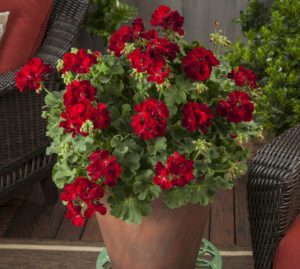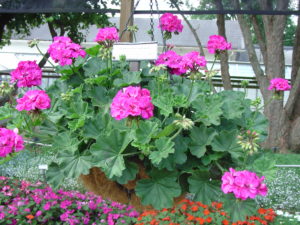Once popular annual geraniums (Pelargonium x) are making a comeback with U.S. gardeners. Geraniums are also planted in window boxes or hanging baskets. Three types of geraniums are sold at garden centers: zonal or bedding geraniums (P. x hortorum), ivy-leaf geraniums (P. peltatum), and Martha Washington geraniums (P. x domesticum). Color choices include red, pink, rose, salmon, orange, lavender, violet, or white.
Of the 3 types, zonal geraniums are the most widely planted. Ivy-leafed geraniums (Pelargonium peltatum) have a trailing habit with ivy-shaped foliage. They are principally planted in hanging baskets and window boxes. Martha Washington geraniums (P. x domesticum) are primarily sold by florists as flowering pot plants and do not perform well outdoors.
High summer heat is challenging for all types of geraniums. Some types of geraniums stop blooming completely and perk up when cool temps return. Over the past quarter century plant breeders have given gardeners more heat-tolerant types, such as the Americana™, Eclipse™, Rocky Mountain™ cutting series; Maverick™, and Orbit™ seed series; and the interspecific hybrids trademarked as Caliente and Calliope.
Plant geraniums outdoors after all threat of frost has passed. Depending on the geranium type and variety, plants are spaced about 8 to 12 inches apart and around the same depth as their original planting pots. Mulch around plants to retain soil moisture and suppress weeds. Deadheading of spent blooms also encourages additional blooming. Avoid overhead irrigation, as this may bring on disease problems. Geranium cuttings root easily and held over as house plants.
Geraniums must have a moist well-drained soil and should be planted in a garden receiving at least 6 – 8 hours of sunlight. Let the soil go slightly dry between waterings. Do not overfertilize. Fertilize with a slow-release, granular product once in spring and/or with a water soluble fertilizer such as Miracle-Gro™ or Jacks™ 1-2 times over the summer. Remove old spent flowers to keep plants blooming. Ideal light exposure is in full morning sunlight and in light afternoon shade.



 Posted in
Posted in 
